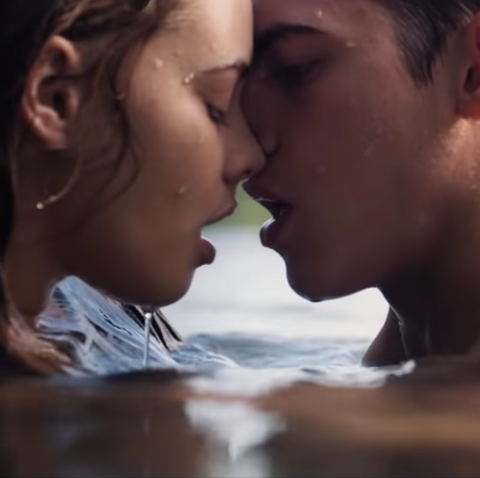By Ross Douthat
We’ll know we’re actually escaping stagnation when the cinema of desire returns.A slight giddiness is overtaking prognosticators as the pandemic nears its end. Economics writers, normally a cautious bunch, are speculating about how a Biden boom might really be different — bigger, longer, its fruits more widely shared — than the limping recoveries we’ve seen recently. Tech and science watchers are talking about the 2020s as an age of breakthroughs, a long-awaited acceleration. But what about culture? If stagnation in the economy has been matched by sterility in social and artistic pursuits (it has), what would signify cultural acceleration or escape? Here’s one possibility: We’ll know we’re actually entering a new era when sex and romance make a comeback at the movies. Note that I said sex and romance. Traditionally these were somewhat separable movie-industry commodities. Eras famous for turbulence and libertinism (Hollywood before the Hays Code, the post-sexual revolution 1970s and 1980s) were more likely to sell sex, while in eras of conservatism or restoration the romantic comedy and the marriage plot prevailed. The two peaks of the “rom-com” were the 1940s and the 1950s and then the 1990s and early 2000s, when even sex comedies passed from being proudly depraved to (in the Judd Apatow era) almost wholesome. But in the last 15 years the “sex movie” and the romantic comedy have both declined or disappeared. This means that if you’re a proud anti-puritan who misses nudity or “adult themes” in your movies or an old-fashioned filmgoer who swoons for true love triumphing over all impediments, you can reasonably complain that Hollywood isn’t telling your kind of stories anymore. In the modern blockbuster, as the film writer R.S. Benedict put it recently: “Everyone is beautiful. And yet, no one is horny.” Movie stars have never been so ripped and chiseled and godlike; they have to be, if they aspire to play a Marvel or DC superhero. But unlike the old Olympians, these gods rarely seem to have the hots for one another, and their movies mostly exist within the parameters of early adolescence, with little adult smoldering permitted. (Adam Driver did his best to break this mold in the recent “Star Wars” movies, but in vain.) It isn’t just the adult rom-com that’s waned. Watching “Raya and the Last Dragon” with my kids last week, I realized that it was the fourth animated Disney movie in a row — following “Onward,” “Frozen II” and “Moana” — without a central love story. (“Frozen II” technically has a marriage-proposal story carried over from its predecessor, but it’s completely vestigial.) A lot of different forces have marginalized movie sex and romance. The blockbuster industry has been bad for all kinds of adult movies, because it’s assumed that superhero fight scenes travel better internationally than more complex and culturally specific plots. Some of the audience for sexually themed stories — the people who used to line up for “Basic Instinct” or, more pretentiously, for sexy art-house fare — has migrated to cable and streaming services; some of that appetite has been sated and deadened by online porn. The decline of the love story has led to a few creative innovations. Hits like the original “Frozen” and HBO’s “Big Little Lies,” for instance, successfully centered female relationships in narratives — the fairy tale, the soap opera — that traditionally foreground romance or sex instead. Still, in general there’s a cultural void where romance used to be. And it doesn’t seem coincidental that this void opened at a time when the sexes are struggling to pair off — with fewer marriages, fewer relationships, less sex. Courtship structures, formal in the old days and casual in the 1990s, were always useful to the romantic comedy. But lately even the casual structures have collapsed, with a Darwinian ecosystem of online dating (much less charming in reality than on “You’ve Got Mail”) supplanting older, more cinematic alternatives. Ideological trends have also made it more challenging to portray happy relations between the sexes. The dramatic material of traditional romance is male and female distinctiveness, different forms of la différence. But these differences sit uncomfortably with the current progressive emphasis on the interchangeability of the sexes — which may be why the recent cable hits with the most sex or romance have been set in historical and fantasy landscapes, from “Game of Thrones” to “Outlander,” where certain problematics can be forgiven (to a point) as essential to the setting. Just consider the contrast between Netflix’s “Bridgerton,” a multiracial bodice-ripper set in an alternative but safely-past-tense 19th century, and the best picture nominee “Promising Young Woman,” set in a present-day dating landscape so bleak that it makes you want to cancel heterosexuality itself. But maybe the popularity of “Bridgerton” is a foretaste of a very different 2020s. Maybe it’s a sign that an age of libertinism lies just around the corner. Or maybe the show’s particular concern with married sex is a signpost on the path to a new traditionalism. Either way, everyone should be rooting for the cinema of desire. For artistic reasons, yes — but also for the sake of the continuation of the human race. https://www.nytimes.com/2021/03/20/opinion/sunday/sex-romance-movies.html?action=click&module=Opinion&pgtype=Homepage

No comments:
Post a Comment